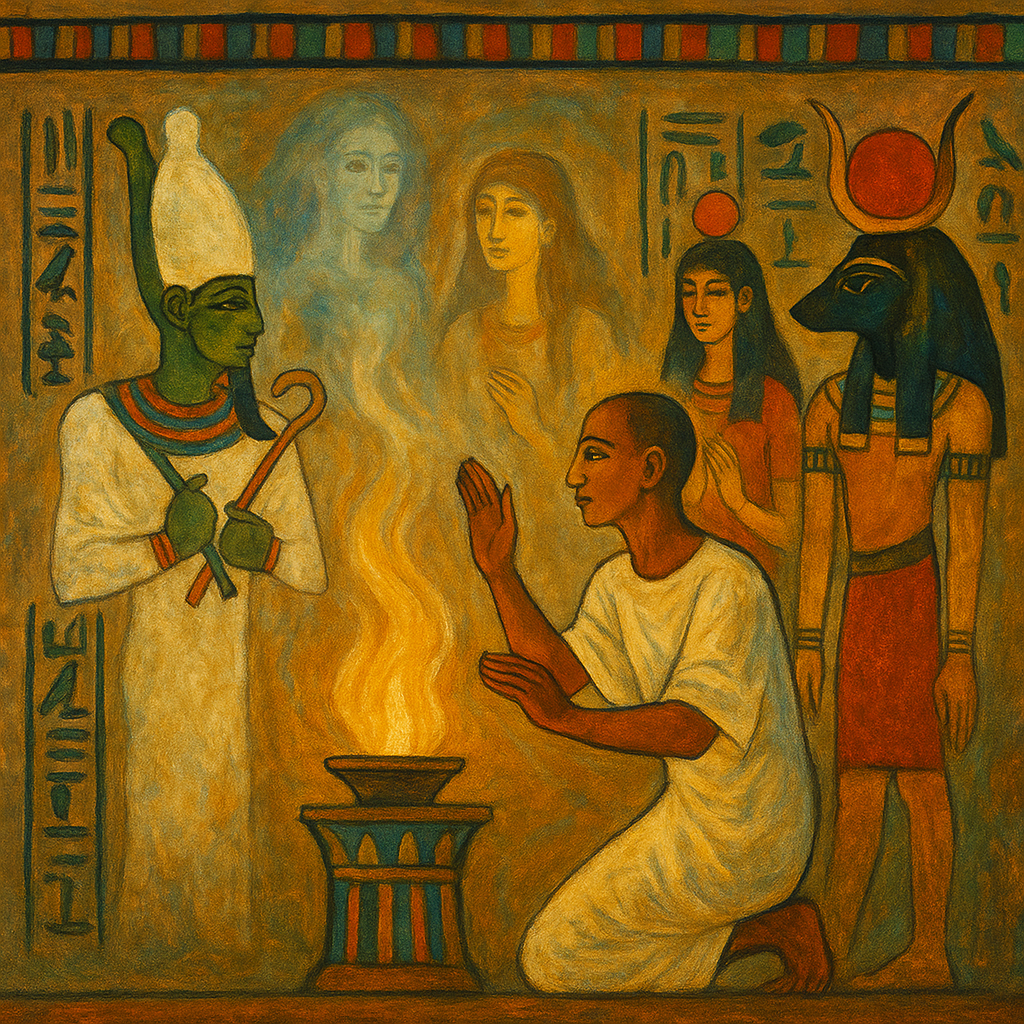Egyptian Beliefs in Spirit Communication, Mediumship, and Spiritual Dimensions
Introduction
The ancient Egyptians developed one of the most elaborate spiritual systems in human history. Their worldview was deeply shaped by the belief that life continued after death and that the living could communicate with the dead and the gods across multiple spiritual dimensions. Spirit communication, ritual mediumship, and the guidance of deities and ancestors were essential for maintaining balance in both earthly life and the afterlife.
Egyptian Cosmology: The Layers of Existence
Egyptian religion described a multi-dimensional universe, governed by divine order (ma’at):
The Physical World: Daily life along the Nile, infused with spiritual presence.
The Duat (Underworld): A spiritual dimension traversed by the soul after death, filled with guardians, trials, and divine judges.
The Afterlife (Field of Reeds): A perfected realm where the blessed dead lived eternally, reflecting the ideal version of Egypt.
The Divine Realms: Domains of the gods, from solar deities like Ra to the chthonic presence of Osiris and Anubis.
These interwoven dimensions made communication with spirits and gods a constant necessity.
Spirit Communication in Ancient Egyptian Traditions
1. Ancestor Communication
Egyptians believed that the ka (life force) and ba (soul-personality) of the deceased survived after death.
Letters to the dead, written on papyrus or pottery, were placed in tombs to request guidance, blessings, or intervention.
Daily offerings of food, drink, and incense ensured ongoing dialogue with ancestors.
2. Mediumship and Priestly Intermediaries
Priests served as mediums between gods and humans, conducting rituals in temples where statues were believed to embody divine presence.
During rituals, priests recited spells and performed offerings to invite deities to communicate through sacred images.
Oracles, often delivered through temple priests, gave divine answers to questions about justice, healing, or the future.
3. Dreams and Divine Visitations
Dreams were a powerful form of spirit communication. Egyptians visited dream temples, such as those dedicated to Serapis or Imhotep, to receive healing and prophecy from the gods.
Both ordinary people and kings recorded visions where ancestors or gods spoke directly.
Spirits, Deities, and the Afterlife
Egyptian belief included a wide spectrum of beings who interacted with humans:
The Akh (Transfigured Spirit): A blessed form of the dead that could intervene in human affairs.
Gods and Goddesses: Ra, Osiris, Isis, Anubis, Hathor, and others communicated through ritual, dreams, and temple presence.
Protective Spirits: Amulets and spells invoked guardians against harmful entities.
Restless Dead: Those without proper burial or offerings could return as angry spirits, requiring appeasement rituals.
Rituals and Techniques of Spirit Contact
Funerary Texts: The Book of the Dead and Coffin Texts served as manuals for communicating with the afterlife and guiding souls through the Duat.
Oracles and Divination: Questions posed to statues of gods during temple festivals were answered through priestly interpretation.
Incantations and Magic (Heka): Ritual specialists used spells to summon protective spirits or request aid from deities.
Offerings and Festivals: Daily tomb rituals and annual festivals (such as the Feast of the Valley) renewed bonds between the living and the spirits of the dead.
Mediumship and Community Life
Spirit communication was not limited to priests and pharaohs:
Families maintained ongoing relationships with deceased relatives, treating them as active participants in family affairs.
Community rituals allowed groups to honor protective deities and ancestral spirits.
In healing, mediums and ritual healers invoked divine or ancestral spirits for protection against illness or misfortune.
Comparisons with Western Mediumship
Similarities: Communication with ancestors, dreams as spirit visitations, priestly mediation, and ritual invocation.
Differences: Egyptian mediumship was highly institutionalized, tied to temples, tombs, and state religion. Spirit communication emphasized cosmic order, moral judgment, and eternal life, rather than personal survival evidence.
Continuity and Legacy
Though the ancient religion transformed with the rise of Christianity and Islam, elements of Egyptian spirit communication endure:
Folk practices in Egypt still include dreams, ancestor reverence, and shrine offerings.
Global fascination with the Book of the Dead continues to shape modern understandings of spirit realms and afterlife journeys.
Conclusion
Egyptian beliefs in spirit communication, mediumship, and spiritual dimensions reveal a world where ancestors, gods, and spirits constantly interacted with the living. Through offerings, dreams, priestly rituals, and sacred texts, Egyptians sustained a dynamic dialogue across dimensions.
Unlike Western Spiritualism, Egyptian practices were deeply woven into cosmic order, social duty, and eternal destiny, making them one of the most enduring and influential systems of spirit communication in human history.

